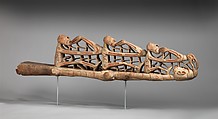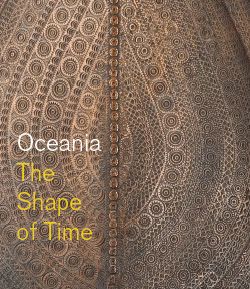Canoe Prow
Not on view
Living along the rivers of the coastal swamps of Southeast New Guinea, the Asmat people have historically depended on canoes for transportation. Asmat canoe prows, especially those of large communal vessels used for trade, food gathering, and, formerly, warfare, are often ornately carved with complex openwork compositions combining human and animal imagery with geometric forms. Nearly all human images in Asmat art represent and are named for recently deceased individuals. Here, the large reclining figure depicts Pokor—probably the artist's father—who supports three seated figures representing, from back to front, his wife Ombe, and Shibishak and Torapit, two of his children.
In his collecting among the Asmat, Michael Rockefeller sought to acquire outstanding works and to document their artists, imagery, and original contexts as fully as possible. His thoroughness is evident in his collection of art forms associated with canoes. Rockefeller acquired more than twenty canoe prows, over forty paddles, and commissioned the complete canoe exhibited in the <a href="/collections/galleries/africa-oceania-and-the-americas/354">Oceanic galleries</a>. He also arranged and photographed a demonstration of the use of a group of canoes to capture, as he wrote, "sculpted canoe prows in action, the grace of the movements involved in paddling . . . the pageantry of the occasion for the Asmat."
Due to rights restrictions, this image cannot be enlarged, viewed at full screen, or downloaded.
This artwork is meant to be viewed from right to left. Scroll left to view more.




